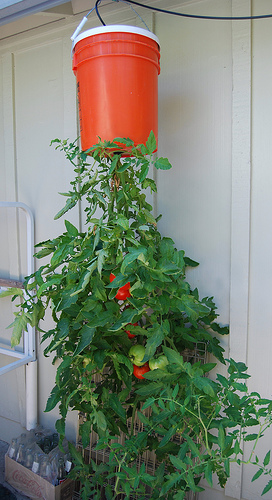Living
Urban farming: planting upside down is IN!
2010.06.14 Angie Amasawa

Tomato Update:Creative Commons,Some Rights Reserved,Photo by kkimpel
Hanging baskets are commonly seen with flowers planted in it, but how would you react if you see tomato plants hanging upside down instead? Recently in the United States, there are increasing number of gardeners who practices "upside down
planting", where they hang a plastic bucket with about 5 cm diameter hole at the bottom and plant vegetables or herbs upside down from the hole.
While some people reuse plastic bottles for upside down planting, commercial upside down planting kit has been on sale at various retailers since 2005, and 20 million kits were sold. Especially, this year's sale is double of last year's, which shows the big hit of the product.
Through hanging plants in the air, there are less pests and fungus to be worried about, and it save space. Additionally, there are advantages such that nutrients and water are delivered to plants efficiently because of gravity, and depending on the vegetables, it would reduce the stress on the vine caused by fruits. While there are some urban farmers that report, "The plants seem to stay healthier and yield better produces upside down compared to planting in the ground," horticulturalists and plant scientists agree with the fact that it would prevent pests, but are unsure of whether it would result in a better produce. Furthermore, because it is being hanged upside down, soil inside the planter tends to get dry faster, which requires more frequent watering compared to other planting methods.
It was reported that upside down planting is effective for plants such as tomatoes, cucumbers, and basils. Although some vegetables or herbs are preferred than one another for this type of planting, if you are troubled with pests, it may be worth a try to plant your vegetables upside down.
Related URL/media
http://www.nytimes.com/2010/05/20/garden/20tomato.html?src=me&ref=general
![]()









